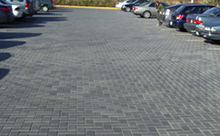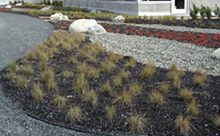Permeable pavement, also known as pervious or porous paving, is a type of hard surfacing that allows rainfall to percolate to an underlying reservoir base where rainfall is either infiltrated to underlying soils or removed by a subsurface drain.
Permeable pavement can be used instead of standard asphalt and concrete for surfacing sidewalks, driveways, parking areas, and many types of road surfaces. Standard asphalt and concrete are considered to be “impermeable.” Precipitation that falls on or drains to them cannot flow through the surface to the soils below, but runs to the lowest points to be drained away.
Permeable pavements include:
- individual unit paving blocks or cobble stones,
- plastic or fibrous grid systems filled with sand, gravel or living plants, or
- specialty mixes of both concrete and asphalt
Permeable asphalt and concrete do not look markedly different from their impervious counterparts, but a close inspection can reveal larger surface “pores.” Permeable unit pavers and grid systems are usually easier to distinguish from a distance.
Types of Permeable Pavement
Unit Pavers
These consist of interlocking concrete paving blocks separated by narrow gaps (pores) which are filled with sand and/or gravel, as specified by the manufacturer. These gaps allow stormwater to drain into a stone filled reservoir base below the surface, and then into the underlying soils. If the native soil below the paved area has poor permeability, the reservoir can be designed to store rainwater. Typically, overflow from extremely large storms is conveyed to municipal drainage systems off-site. Permeable pavers are most often seen in use for private driveways, walkways, parking areas at the edge of roadways and parking lots. They are not considered appropriate for heavy volume roads and highways.
Grass Pavers
Grass pavers consist of concrete cells or a strong plastic grid system with large pore spaces filled with a growing medium planted with grass or a low growing herb. This type of product is often used in low-traffic vehicle movement areas such as fire access lanes, long term parking slots and private driveways. Areas often include reservoir bases and underdrain systems similar to unit pavers.
Gravel Pavers
These are similar to grass pavers except that the growing medium is replaced with gravel and no plant materials are used. The look is similar to a simple gravel parking lot but the grid system helps keep gravel pieces in place over time, preventing ruts and worn spots.
Permeable Asphalt
This pavement consists of an open-graded coarse aggregate, bonded together by asphalt cement, with sufficient interconnected open spaces to make it highly permeable to water.
Permeable Concrete
This concrete has a much larger than usual void space, with little or no “fines” material in the mix. This allows water and air to move quickly through the material to the soils or the base layer below. It typically consists of specially formulated mixtures of Portland cement, uniform, open-graded coarse aggregate, and water. Porous concrete has been used on highways to reduce hydroplaning.
Advantages of Permeable Pavement
Runoff Volumes
Research has shown that pavers can significantly reduce runoff volumes, thereby reducing the erosive power of stormwater entering creeks and inter tidal areas. This helps to protect backwater refuges, brings less sediment to spawning areas, prevents down cutting of streams and loss of bank stability.
Pollutant Removal
Long term research on permeable pavers shows their effective removal of pollutants such as total suspended solids, total phosphorous, total nitrogen, chemical oxygen demand, zinc, motor oil, and copper. In the void spaces, naturally occurring micro-organisms break down hydrocarbons and metals adhere.
Groundwater Recharge
In areas with suitable soils, permeable pavements allow stormwater to enter the sub-soils, replicating the natural hydrological cycle by allowing for groundwater recharge and moderating the fluctuations of flows in watercourses.
Heat Pollution
Porous pavement can help lower high runoff water temperatures commonly associated with impervious surfaces. Stormwater pools on the surface of conventional pavement, where it is heated by the sun and the hot pavement surface. By rapidly infiltrating rainfall, porous pavement reduces the water’s exposure to sun and heat. Cool stream water is essential for the health of many aquatic organisms, including trout and salmon.
Infrastructure Performance
Using permeable pavement surfaces reduces the amount of effective impervious area (EIA), in an existing development. (EIA is the hard surface area directly connected to municipal drainage systems.) Reduction of EIA improves the performance of existing on-site cleansing, infiltration and storage facilities, which thus process less stormwater flow.
Infrastructure Footprint
A reduction in EIA can help reduce the size of the on-site stormwater storage technique required in many municipalities, potentially freeing up land surface for other more valuable uses.
Longevity/Maintenance
While there is little historical evidence, many concrete paver manufacturers claim their product will last 50 years or more. In comparison, asphalt parking lots last a far shorter time, especially in freeze/thaw climates. Frequent crack filling and overlaying, some restriping and at least one reconstruction, would be required within a 50-year span.
Conversely, the maintenance required on a permeable concrete paver system is claimed, depending upon the source, to be from minimal to onerous. Maintenance consists of restriping and occasional cleaning of the aggregate within the pore area by vacuum truck. The latter needs to perform only on a case-by-case basis, depending on how the pavement is performing.
Limitations of Permeable Pavement
Runoff Volumes
Permeable pavements are designed to replace effective impervious areas, not to manage stormwater from other impervious surfaces on site. Use of this technique must be part of an overall on site management system for stormwater, and is not a replacement for other techniques.
Pollutant Load
Highly contaminated runoff can be generated by some land uses where pollutant concentrations exceed those typically found in stormwater. These "hot spots" include commercial nurseries, recycling facilities, fuelling stations, industrial storage, marinas, some outdoor loading facilities, public works yards, hazardous materials generators (if containers are exposed to rainfall), vehicle service and maintenance areas, and vehicle and equipment washing and steam cleaning facilities. Since porous pavement is an infiltration practice, it should not be applied at stormwater hot spots due to the potential for ground water contamination. All contaminated runoff should be prevented from entering municipal storm drain systems by using best management practices for the specific industry or activity.
Weight & Traffic Volumes
Reference sources differ on whether low or medium traffic volumes and weights are appropriate for porous pavements. For example, around truck loading docks and areas of high commercial traffic, porous pavement is sometimes cited as being inappropriate. However, given the variability of products available, the growing number of existing installations in North America and targeted research by both manufacturers and user agencies, the range of accepted applications seems to be expanding. Some concrete paver companies have developed products specifically for industrial applications. Working examples exist at fire halls, busy retail complex parking lots, and on public and private roads, including intersections in parts of North America with quite severe winter conditions.
Siting
Permeable pavements may not be appropriate when land surrounding or draining into the pavement exceeds a 20% slope, where pavement is down slope from buildings or where foundations have piped drainage at their footers. The key is to ensure that drainage from other parts of a site is intercepted and dealt with separately rather than being directed onto permeable surfaces.
Climate
Cold climates may present special challenges. Road salt contains chlorides that could migrate through the porous pavement into ground water. Snow plow blades could catch block edges and damage surfaces. Infiltrating runoff may freeze below the pavement, causing frost heave, though design modifications can reduce this risk. These potential problems do not mean that porous pavement cannot be used in cold climates. Porous pavement designed to reduce frost heave has been used successfully in Norway. Furthermore, experience suggests that rapid drainage below porous surfaces increases the rate of snow melt above.
Cost
Some estimates put the cost of permeable paving at two to three times that of conventional asphalt paving. Using permeable paving, however, can reduce the cost of providing larger or more stormwater BMP’s on site and these savings should be factored into any cost analysis. In addition, the off-site environmental impact costs of not reducing on-site stormwater volumes and pollution have historically been ignored or assigned to other groups (local government parks, public works and environmental restoration budgets, fisheries losses, etc.) The City of Olympia in Washington State is studying the use of porous concrete quite closely and finding that new stormwater regulations are making it a viable alternative to stormwater ponds.
Longevity/Maintenance
Grass pavers require supplemental watering in the first year to establish the vegetation, otherwise they may need to be re-seeded. Regional climate also means that most grass applications will go dormant during the dry season. While brown vegetation is only a matter of aesthetics, it can influence public support for this type of permeable paving.
Olympia, Washington has found that porous concrete mix quality can be difficult to control, as it is sensitive to water and difficult to blend correctly. The city is still working on how, and how often, to clean porous concrete. Olympia expects to solve these problems as it gains more experience.
Performance Records & Measures
for Permeable Pavement
Results of studies have shown that permeable pavement systems dramatically reduce surface runoff volumes and peak discharge. As well, standard water quality indicators are significantly reduced. Research also indicates that, as with any stormwater management technique or device, permeable paving performs well over time if properly installed and maintained.